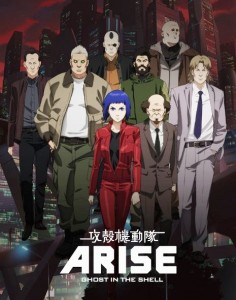Justin’s Japan: ‘Dragon Ball Z,’ ‘Naruto’ Come to the Big Screen
By JQ magazine editor Justin Tedaldi (CIR Kobe-shi, 2001-02) for Shukan NY Seikatsu. Visit his Examiner.com Japanese culture page here for related stories.
This August will be a hot month for anime fans, as the latest feature length entries for two of the world’s most popular series debut at Village East Cinema.
First up (Aug. 5 and 9) is “Dragon Ball Z: Battle of Gods,” the 18th animated feature of author Akira Toriyama’s massively popular martial arts adventure series “Dragon Ball,” which celebrates its 30th anniversary this year. The plot focuses on the dessert-loving God of Destruction Beerus, who awakes from a decades-long slumber to challenge Goku, the strongest fighter in the universe.
“‘Dragon Ball Z’ has been a gateway for me personally. Growing up watching Toonami in the ’90s, the series influenced me as a kid to become obsessed with Japanese animation,” said Maj Mack, founder and CEO of GoBoiano, a fast-growing anime startup with over 300,000 social media followers worldwide.
Another long-running series (fifteen years and counting), “Naruto,” premieres Aug. 31-Sept. 1 with its ninth feature film, “Road to Ninja: Naruto the Movie.” Set in an alternate timeline in which its characters have different origin stories and personalities, and featuring the theme song “Sore de wa, Mata Ashita” by the J-rock band Asian Kung-Fu Generation, “Road to Ninja” became the highest grossing “Naruto” movie to date within two months of its release in Japan.
For tickets, visit www.fandango.com.
WIT Life #272: Japan Cuts
WIT Life is a periodic series written by professional Writer/Interpreter/Translator Stacy Smith (Kumamoto-ken CIR, 2000-03). She starts her day by watching Fujisankei’s newscast in Japanese, and here she shares some of the interesting tidbits and trends along with her own observations.
This weekend wrapped up Japan Society’s annual film festival Japan Cuts, and all of the films that I caught out of the 28 presented this year were wonderful. I particularly enjoyed the opening film on the first Friday of the festival, The Snow White Murder Case (白ゆき姫殺人事件). This movie made its U.S. premiere, and told the story of the murder of a beautiful young office worker. The prime suspect is her plain co-worker who has disappeared following the murder, and in the online world the case is made for her guilt before the official investigation takes place. As interviews are carried out with others at the company and the truth is gradually revealed, viewers come to realize how culpable we are in automatically convicting suspects based on hearsay and popular opinion. This film skillfully highlights just how pernicious social media can be in stringing people up before they have the opportunity to defend themselves. Although this sounds like a dark story, it also has comic moments that serve to lighten the mood.
Two kid-centered films that I liked more than I expected were Maruyama, the Middle Schooler (中学生円山) and Hello! Junichi (ハロー!純一), both of which use dance and humor to great effect. The former focuses on a 14-year old in the height of puberty who uses his active imagination to Read More
JET Talks Film Screening – “Kokoyakyu High School Baseball” Documentary and Q&A Panel
JETAA DC is proud to present the launch of JET Talks– a speaker series modeled after TED Talks that will feature dynamic and interesting individuals to inspire innovative ideas and conversation on Japan within the DC community.
Upcoming Events: Kokoyakyu Documentary and Q&A – Tuesday, July 22
Play Ball! On July 22, please join JETAADC at the Japan Information and Culture Center (1150 18th St NW #100, Washington, DC 20036) as it presents its first “JET Talk” of the 2014-2015 season: a screening of the award winning documentary Kokoyakyu: High School Baseball, followed by a discussion with two of the film’s producers.
Kokoyakyu is the first English-language film to examine high school baseball in Japan, in particular, the annual summer high school baseball tournament. The film follows one team as it seeks to play in the prestigious tournament, and along the way demonstrates why high school baseball has become a national rite of passage for many of Japan’s youth.
Following the film, Nick Harling (Mie-ken, 2001-03), JET Talks Co-Chair and creator of the Let’s Talk Japan Podcast, will lead a discussion with Kokoyakyu’s Producers Alex Shear and Takayo Nagasawa as they discuss the making of the film and the differences between the U.S. and Japan when it comes to the “National Pastime.”
Click here to register for Kokoyakyu.
Light refreshments will be served. Identification will be required to consume alcoholic beverages. Admission is free, but you must preregister.
If you have an interesting and dynamic speaker you’d like to hear speak on anything related to Japan, email us at jet.talks@jetaadc.org.
JQ Magazine: Film Review – JAPAN CUTS 2014 at Japan Society
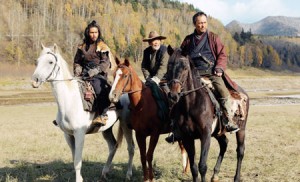
Ken Watanabe (right), stars in Unforgiven, premiering July 15 at Japan Society in New York as part of their annual JAPAN CUTS film festival. (© 2013 Warner Entertainment Japan Inc.)
By Lyle Sylvander (Yokohama-shi, 2001-02) for JQ magazine. Lyle has completed a master’s program at the School of International and Public Affairs at Columbia University and has been writing for the JET Alumni Association of New York since 2004. He is also the goalkeeper for FC Japan, a New York City-based soccer team.
This year’s JAPAN CUTS—North America’s biggest festival of new Japanese film—kicks off July 10-20 at New York’s Japan Society, continuing its tradition of showcasing the latest films from Japan along with some special guest stars and filmmakers. This year’s highlights include Japan’s blockbuster The Eternal Zero, The Great Passage (Japan’s submission for the Academy Award last year) and the post-3/11 documentary The Horses of Fukushima. Below are three of the 28 films in this year’s lineup that were made available to JQ at press time.
Eiji Uchida’s Greatful Dead marks the latest entry in the “dark and twisted” Japanese genre. The sordid story follows Nami (Kumi Takiuchi) as she follows “solitarians” (old and psychotic loners) around Tokyo and snaps selfies with them when they die. She enters into a morbid friendship with one particular “solitarian” (Takashi Sasano) and the rest of the film explores the darker side of humanity and mental illness in modern-day Japan. Uchida also seems to be making a statement about those most marginalized in modern Japan—the young and the elderly. Japan’s youth have a staggeringly large unemployment rate while the aging demographic makes for a perilously underfunded social security system.
Also using horror conventions for social satire is Miss Zombie, taking place in a futuristic Japan where zombies can be domesticated as servants and pets. Directed by Hiroyuki Tanaka (here using the pseudonym “Sabu”), Miss Zombie follows Shara, a mail order zombie whose owner, Dr. Teramoto, feeds her rotten vegetables in exchange for domestic labor. The film takes a darker turn as she is raped by two handymen—an event that sexually arouses Dr. Teramoto. Soon, Shara’s services are no longer limited to domestic chores. Even Dr. Teramoto’s wife finds her services useful after their son drowns. Overall, Sabu brings a fresh and interesting approach to the zombie film—a far cry from the works of George A. Romero and the countless imitators he inspired.
Justin’s Japan: Nippon in New York — Kabuki at Lincoln Center, JAPAN CUTS, NY Mets, DJ Krush
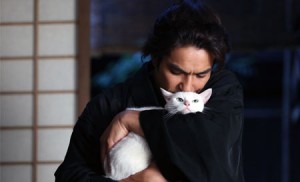
Neko Samurai ~Samurai ♥ Cat~ makes its international premiere as part of Japan Society’s annual JAPAN CUTS film festival July 19 with a live appearance by star Kazuki Kitamura. (© 2014 NEKO SAMURAI PRODUCTION COMMITTEE)
By JQ magazine editor Justin Tedaldi (CIR Kobe-shi, 2001-02) for Examiner.com. Visit his Japanese culture page here for related stories.
After you’ve seen the outdoor fireworks, enjoy some summer events in the cool indoors, whether it’s witnessing the return of one of the world’s most distinguished kabuki companies returning to New York after seven years, catching one of 20 films in Japan Society’s annual festival, or waiting for the bass to drop at a live performance from a legendary DJ.
July 7-12
Rose Theater, 10 Columbus Circle
$45-$190
The Heisei Nakamura-za company, which made its North American debut in a critically acclaimed and sold-out run during Lincoln Center Festival 2004, was founded by the illustrious Kanzaburo XVIII, the late patriarch of the Nakamura family—a veritable kabuki dynasty in Japan with an unbroken line of actors and innovators reaching back to the 17th century. For its Lincoln Center Festival engagement, the company has revived a rarely performed 19th-century ghost story, Kaidan Chibusa no Enoki (The Ghost Tale of the Wet Nurse Tree), about the murder of an artist by a handsome samurai who desires the artist’s wife. Running the emotional gamut from drama to uproarious slapstick comedy, and culminating in a thrilling fight-to-the-death beneath a waterfall, this is kabuki theater at its most engaging. Performed in Japanese with English synopsis via a headset.
July 10-20
Japan Society, 333 East 47th Street
$10-$20
North America’s biggest festival of new Japanese film returns for its eighth year, serving up a thrilling cross section of Japan’s diverse film cultures to New York audiences! Screening 27 features across 10 days, including co-presentations with the 13th New York Asian Film Festival, JAPAN CUTS premieres the best of recent action epics, genre oddities, touching dramas, warped comedies and cutting-edge arthouse cinema made in and around Japan. Plus, meet special guest stars and filmmakers during exclusive post-screening Q&As and raucous parties in Japan Society’s theater and atrium!
Friday, July 11, 5:30 p.m.
New York Mets Japanese Heritage Night 2014
Citi Field, 123-01 Roosevelt Avenue
Special seating $35-$72
For the fifth annual Japanese Heritage Night at Citi Field, the Mets take on the Miami Marlins for this special event. The pre-show kicks off at Mets Plaza outside with an explosive taiko set from New York’s own Soh Daiko, followed by the Mets Spirit Awards inside the stadium given to honored members of the New York Japanese and Japanese American community. Prior to the first pitch at 7:00 p.m., the Japanese Men’s Choir will perform our national anthem. A portion of the proceeds from each ticket bought will go to Japanese community charities through the Japanese American Association of New York. Be sure to look for fun Japanese activities and games throughout the evening at the special tables on the main concourse behind the giant video screen. Price of ticket includes a free T-shirt!
For the complete story, click here.
WIT Life #271: New York Japan Cinefest at Asia Society
WIT Life is a periodic series written by professional Writer/Interpreter/Translator Stacy Smith (Kumamoto-ken CIR, 2000-03). She starts her day by watching Fujisankei’s newscast in Japanese, and here she shares some of the interesting tidbits and trends along with her own observations.
Last week I went to the 3rd annual New York Japan CineFest held at Asia Society. It featured six short films ranging in length from 4-30 minutes, many of which had already received awards at other film festivals. I attended with fellow JET alums, so it was fun to dissect the films together and relate them to our respective Japan adventures. The event opened with The Misadventures of Incredible Dr. Wonderfoot, and directors Grier Dill and Brett Glass were on hand to offer an introduction.
In addition, two of the movie’s stars, Tsukasa Kondo and Tadashi Mitsui, also shared their experiences of making the film. The former is actually one of the creators and stars of the web series Second Avenue, which follows two 20-something Japanese roommates in Brooklyn, an aspiring actress and a Japanese gay law student (played by Kondo). The first season of six episodes (mostly in Japanese with subtitles) are really entertaining, especially for viewers who understand Kansai-ben .
.
It was fun to watch the quirky podiatrist Dr. Wonderfoot, but my personal favorite out of all the flicks (and audience award recipient) was one of the concluding films, Little Kyota Neon Hood (I also liked the final film Lil Tokyo Reporter that was based on the true story of L.A. Japanese-American community leader Sei Fujii). This film takes place in Tohoku and features 10-year old Kyota who is suffering from Read More
Justin’s Japan: ‘Ghost in the Shell,’ Kishi Bashi, Luna Haruna at AnimeNEXT
By JQ magazine editor Justin Tedaldi (CIR Kobe-shi, 2001-02) for Examiner.com. Visit his Japanese culture page here for related stories.
After an unusually chilly spring, it’s finally starting to feel like summer. Enjoy some seasonal events this month that celebrate the best of both fine art and pop art.
This month’s highlights include:
Wednesday, May 28, 10:00 p.m.
The Bowery Electric, 327 Bowery
$5
An all-female quartet that delivers riff-heavy, post-punk anthems, Each of the Hard Nips came to live in New York at different times, from different parts of Japan. And, as conspired by the ever-dexterous hand of fate, they were to cross paths and become fast friends. They quickly formed a cult-like bond whose rituals all included drinking a lot of alcohol and uncontrollably running their mouths. The wine flowed like Kool-Aid and, somehow, they found themselves buying into the delusion that they were capable of forming a kick-ass rock band. Witness the next chapter in their story, with support from Shakes and the Johnnys.
Thursday, May 29, 7:30 p.m.
Ghost in the Shell: Arise – Borders: 1 & 2
AMC Loews Village 7, 66 Third Avenue
$10
In the first two parts of this highly anticipated prequel series of the anime sensation Ghost in the Shell, it’s the year after the fourth World War and cyborg/hacker Motoko Kusanagi finds herself wrapped up in the investigation of a devastating bombing. But she’s not the only one looking for answers—as she delves deeper into the mystery of who is behind the attack, a specialized team unlike any before begins to take shape.
June 6-8
Garden State Convention Center, 50 Atrium Drive, Somerset, NJ
$45-$60
The largest independently organized anime convention in the New York/New Jersey metropolitan area. AnimeNEXT features Japanese creators of anime and manga, voice actors, musical acts, artists, vendors and exhibits, events, panels, workshops, and gaming. This year’s musical guest is Tokyo’s Luna Haruna, who made her major debut in 2012 with the song “Soraha Takaku Kazeha Utau,” the ending theme song for the second season of anime series Fate/Zero. Her latest single, “Snowdrop,” was featured as the ending theme song the second season of Monogatari. Don’t miss her first-ever performance on the East Coast!
For the complete story, click here.
WIT Life #270: Godzilla!
WIT Life is a periodic series written by professional Writer/Interpreter/Translator Stacy Smith (Kumamoto-ken CIR, 2000-03). She starts her day by watching Fujisankei’s newscast in Japanese, and here she shares some of the interesting tidbits and trends along with her own observations.
This year marks the 60th anniversary of the first Godzilla movie, and last week the newest version was released. The cast features familiar names like (a wooly-haired and wild-eyed) Bryan Cranston, Juliette Binoche and Ken Watanabe. It has our favorite kaiju (monster) taking on a pair of MUTOs (Massive Unidentified Terrestrial Organisms), the new kaiju on the block. They are ancient parasites that come from the same era and ecosystem as Godzilla, and feed off of radiation like him. In addition to destroying American cities, the male and female MUTO terrorizing the U.S. are looking to mate.
 Cranston and Binoche play an engineer couple who lived in Japan with their young son in 1999, working together at the Janjira nuclear plant where something went wrong. She perished during this accident, and the movie is set in the present day when he is determined to find out what exactly happened, as he doesn’t believe that it was a natural disaster as is being claimed. Watanabe’s character is the moral compass of the movie, a scientist who knows all about Godzilla and his kind. He adds Read More
Cranston and Binoche play an engineer couple who lived in Japan with their young son in 1999, working together at the Janjira nuclear plant where something went wrong. She perished during this accident, and the movie is set in the present day when he is determined to find out what exactly happened, as he doesn’t believe that it was a natural disaster as is being claimed. Watanabe’s character is the moral compass of the movie, a scientist who knows all about Godzilla and his kind. He adds Read More
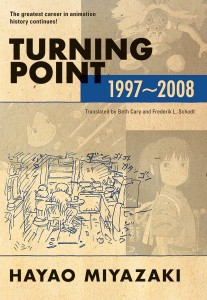
“With wit and humor, Miyazaki offers insight from his long career with every turn of the page. Like an unforgettable sunset or the first time a cooking experiment came out well, he discusses experiences that leave you unexpectedly changed.” (VIZ Media)
By Alexis Agliano Sanborn (Shimane-ken, 2009-11) for JQ magazine. Alexis is a graduate of Harvard University’s Regional Studies—East Asia (RSEA) program, and currently works as an executive assistant at Asia Society in New York City.
I consider myself an aficionado of director and animator Hayao Miyazaki and Studio Ghibli. Having seen his work countless times, visited the museum in Tokyo and done a fair amount of supplemental reading, I figured Turning Point—a collection of Miyazaki interviews and articles spanning 1997 through 2008 and newly translated by Beth Cary and Frederik L. Schodt—would probably be a rehash of the similar. I presumed it would be a book for Japan or anime specialists. On the back cover there’s even a quote from the L.A. Times: “Essential reading for anyone interested in Japanese or Western animation.” However, this statement is entirely too narrow and ultimately misleading.
In fact, the book (which is a sequel to Starting Point: 1979-1996, also translated by Cary and Schodt and now available in paperback) is less about animation and Japan than it is the human condition and those existential questions that keep you awake at night. Miyazaki, at one moment reserved and the other candid, plunges fearlessly into complex, introspective and intellectual issues about human’s relationship with education, child-rearing, philosophy, history, art, environmentalism and war (to name a few).
He does this with a sprinkle of romanticism and a dusting with realism. Using his seemingly continual dissatisfaction with the world, Miyazaki aims to positively spark change and inspire. He insists that his films are not just flights of fancy; rather, he makes them to motivate the next generation to improve the world. “Children learn by experiencing…it is impossible to grow up without being hurt,” he writes. “Experiences like: accepting the duality of human nature, the importance of grit, conviction, and perseverance, and respecting nature and the land….For children willing to start, our films become powerful encouragement.”
WIT Life #268: New Japanese movies worth seeing
WIT Life is a periodic series written by professional Writer/Interpreter/Translator Stacy Smith (Kumamoto-ken CIR, 2000-03). She starts her day by watching Fujisankei’s newscast in Japanese, and here she shares some of the interesting tidbits and trends along with her own observations.
The cherry blossoms have come and gone since the last time I posted, truly fleeting! I was lucky enough to enjoy them twice this year, both during a trip to Japan last month and at the Brooklyn Botanical Garden’s Sakura Matsuri earlier this month. To get through the long flight over the Pacific I like catching up on movies I missed, and I spent my outward voyage enjoying Oscar nominees and the return trip watching some new Japanese movies. During my inward flight two of the movies I picked, Judge! and The Little House, both featured one of my favorite Japanese actors, Satoshi Tsumabuki.
The former film features Tsumabuki as a young advertising agent who is forced by his boss to go in his place as an international judge for a worldwide TV Advertising Festival taking place in Santa Monica. By great coincidence, his boss’s name is Ichiro Otaki and Tsumabuki’s character’s name is Kiichiro Ota, giving them the same name if written Japanese-style with last name first. Ota points out that when abroad, names are written with first name before last name, but his boss ignores his concerns and sends him off. Another name coincidence is that Ota’s female co-worker Hikari has the same last name (in comparison to Kiichiro, she is amusingly referred to as the “talented Ota” by Otaki).
Kiichiro doesn’t have confidence in his English speaking ability, so he enlists Hikari to Read More
Justin’s Japan: Nippon in New York — Miyazaki, Godzilla, Tribeca Film Festival, Sakura Matsuri

New York’s 33rd annual Sakura Matsuri will be held at Brooklyn Botanic Garden April 26-27. (Mike Ratliff)
By JQ magazine editor Justin Tedaldi (CIR Kobe-shi, 2001-02) for Examiner.com. Visit his Japanese culture page here for related stories.
Spring has sprung in the Big Apple, and that means one thing: a new season of sounds, colors, and spectacular performing arts to match the blossoming sakura trees throughout the city.
This month’s highlights include:
Tuesday, April 8
Turning Point: 1997-2008 by Hayao Miyazaki
MSRP $29.99, $34.99
The companion second volume to the earlier chronicleStarting Point: 1979-1996 (also new in paperback),Turning Point is an insightful collection of essays, interviews, memoirs, and illustrations from legendary animation director Hayao Miyazaki. The new title covers the critical stage in the legendary director’s career when his animated films for Studio Ghibli such as Princess Mononoke, Spirited Away, and Ponyo began to garner a significant international audience. Turning Point follows Miyazaki as his grand vision continued to mature, cinema-lovers worldwide discovered and embraced his creations, and prominent film critics such as Roger Ebert delivered tremendous acclaim for the director’s films. Bringing us up to the present is The Art of The Wind Rises, which captures the art of the film from conception to production, featuring in-depth interviews with the creative team from Miyazaki’s latest—and supposedly final—Academy Award-nominated epic.
April 8-13, 8:00 p.m. and 10:30 p.m.
Gary Burton & Makoto Ozone Duets
Blue Note Jazz Club, 131 West Third Street
$20, $35
Born in Kobe to a jazz organist father, Makoto Ozone came to Boston in 1980 to study at the Berklee College of Music, where multi-Grammy Award-winning vibraphonist Gary Burton was a composition and percussion instructor. After graduation he made his first American solo appearance in 1983 with a recital at Carnegie Hall. The incredibly talented young man struck a record deal with CBS, making his international debut in 1984 with the album OZONE. Burton and Ozone have been collaborators in the duet format for over two decades and recorded the Grammy-nominated Virtuosi in 2002. The versatile Ozone has hosted a TV series in Japan, ventured into electronics, and composed for and played with classical orchestras in addition to working with his own jazz trio from his home in New York.
Wednesday, April 9, 8:00 p.m.
Carnegie Hall, 881 Seventh Avenue
$22.50-$140
Praised by the New York Times when she last appeared at Carnegie Hall as “among the most respected artists of our time” for her “probing and magisterial performances” of Schubert’s last three sonatas, pianist Mitsuko Uchida returns to perform his “Reliquie” Sonata, once mistakenly thought to be the composer’s final work. Also on the program is Beethoven’s all-encompassing and transcendent Thirty-Three Variations on a Waltz by Diabelli.
For the complete story, click here.
WIT Life #265: NY Peace Film Festival
WIT Life is a periodic series written by professional Writer/Interpreter/Translator Stacy Smith (Kumamoto-ken CIR, 2000-03). She starts her day by watching Fujisankei’s newscast in Japanese, and here she shares some of the interesting tidbits and trends along with her own observations.
This past weekend I had the opportunity to attend the NY Peace Film Festival co-hosted by my lovely friend Yumi Tanaka. This year highlighted 11 films over the course of the weekend, many with Q&As with their directors following the screenings. I was lucky enough to be able to interpret for two of the Japanese filmmakers who were Skyped in from Japan for their Q&As (a first for me!). Saturday night featured the documentaries The Targeted Village by Chie Mikami and X Years Later by Hideki Itoh.
The first film focuses on a small village in Okinawa called Takae, which happens to be situated between two American military bases. Residents are fighting against the construction of new helipads in Takae, being installed in preparation for the deployment of Osprey. Their story embodies U.S. military strategy dating back to the Vietnam War, the blocking of the gates to the Futenma base, and their town’s rage against their state.
Depicted here is one of the main characters profiled in the film, a local farmer and father of 4 who just wants to ensure that his children can continue to live their quiet lives. In one scene his young son asks how they will be able to study at school with all the noise from the Osprey flying overhead. The farmer takes part in protests again the helipad construction, and unbelievably the Japanese government brings a case of “traffic obstruction” against not only him and several other peaceful protesters but his 7-year old daughter who was Read More
WIT Life #264: Campaign
WIT Life is a periodic series written by professional Writer/Interpreter/Translator Stacy Smith (Kumamoto-ken CIR, 2000-03). She starts her day by watching Fujisankei’s newscast in Japanese, and here she shares some of the interesting tidbits and trends along with her own observations.
Yesterday I went to see director Kazuhiro Soda’s documentary Campaign (選挙) at Japan Society, being shown as part of Richie’s Electric Eight: The Bold and the Daring (part 2 of the film series honoring Ritchie that I talked about in a recent post). It came out in 2007 and was screened at the Berlin Film Festival that year, and was loved by Ritchie who introduced it at a preview at Tokyo’s Foreign Correspondents Club of Japan. This fascinating, self-funded film follows Soda’s Tokyo University (東大) classmate Kazuhiko Yamauchi in becoming the LDP candidate in a by-election for a seat on the Kawasaki City Council, after relocating there from Tokyo for that purpose. Campaign tells the story of how Yamauchi is groomed as a promising newcomer for this well-established conservative party. The LDP is killing it with Prime Minister Junichiro Koizumi and his reform platform on the national level, but engaged in a close battle with the DPJ on the local level.
Yamauchi’s education extends to his wife Sayuri, a particularly interesting character in the film. He is instructed to refer to her as his “housewife” (「家内」 or kanai) as opposed to “wife” (「妻」 or tsuma), a term they both take umbrage against but become resigned to using. In addition, Yamauchi’s supporters within the LDP’s well oiled local political machine later encourages her to quit her job to focus on her husband’s political career, an idea that outraged her. Yamauchi urges her to Read More
Let’s Talk Japan is a monthly, interview format podcast covering a wide range of Japan-related topics. Host Nick Harling (Mie-ken, 2001-03) lived in Japan from 2001 until 2005, including two great years as a JET Program participant in Mie-Ken. He practices law in Washington, D.C., and lives with his wife who patiently listens to him talk about Japan . . . a lot.
 In this episode, I speak with Ambassador John Malott, President emeritus of the Japan American Society of Washington, DC about the inaugural Cinematsuri Japanese Film Festival (March 23-27). In addition to discussing what it takes to organize such an event, we cover recent trends in Japanese cinematography and introduce some of the best new films from Japan.
In this episode, I speak with Ambassador John Malott, President emeritus of the Japan American Society of Washington, DC about the inaugural Cinematsuri Japanese Film Festival (March 23-27). In addition to discussing what it takes to organize such an event, we cover recent trends in Japanese cinematography and introduce some of the best new films from Japan.
Enjoy!
Nick
If you have not already done so, be sure to “Like” the podcast on Facebook, and follow the podcast on Twitter @letstalkjapan. Additionally, please consider leaving a positive rating and/or review in iTunes.
WIT Life #261: After Life
WIT Life is a periodic series written by professional Writer/Interpreter/Translator Stacy Smith (Kumamoto-ken CIR, 2000-03). She starts her day by watching Fujisankei’s newscast in Japanese, and here she shares some of the interesting tidbits and trends along with her own observations.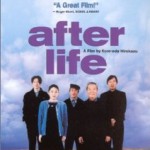
Last night Japan Society concluded its Tribute to Donald Richie: Richie’s Fantastic Five with a screening of After Life (「ワンダフルライフ」), my favorite film from my favorite Japanese director, Hirokazu Kore-eda (The second part of the Richie Tribute, Richie’s Electric Eight, will start on March 13). It was released in 1998, and I remember catching it at the local arts cinema in my hometown. I hadn’t seen Kore-eda’s first film, Maboroshi (「幻の光」), and I was blown away by After Life. Maboroshi was based on a novel by Teru Miyamoto, but After Life is Kore-eda’s original screenplay, one he created after interviewing hundreds regarding recollections of their lives. In the film as well he actually used some of these non-actors to tell their stories.
The movie takes place at a way station where people are sent after they die. They are to reside there for a week, during which time they must pick one memory that they are allowed to take with them into the afterlife. Each counselor is assigned about seven people who they must help make this decision. The style of each employee varies, as does the nature of their clients. We meet elderly deceased who fondly recall their childhoods, as well as young deceased who struggle to find meaning in their short lives. The audience also later learns that the reason Read More


